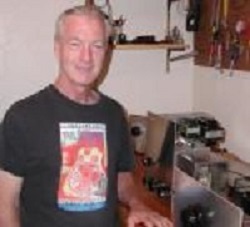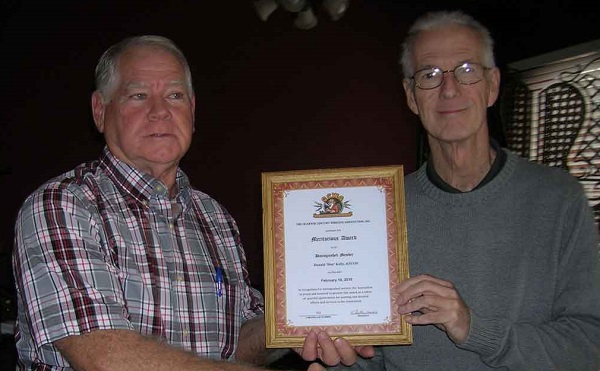 |
Donald W. 'Don' Kelly Edmond, OK QCWA # 36603 Chapter 63 |
Donald Wayne Kelly, 78, of Norborne, MO, passed away to be with our Lord, Jesus Christ, on Sunday, May 2, 2010, at Liberty Hospital, Liberty, MO.
Don was born April 29, 1932 in Knoxville, the youngest of nine children to John Oliver and Hattie (Myers) Kelly. He married Bessie Rose Lindley on June 27, 1954 at the First Baptist Church, Richmond, MO; she survives, of the home.
Survivors include one son and daughter-in-law, Terrill and Helen Kelly of Smithville, MO; three daughters and two sons-in-law, Terri Johnson of Gower, MO, Tammie and Kenneth Welker of Perryville, MO, and Tina and Nelson Pike of Liberty, MO; two sisters, Dorothy Adams of Richmond and Helen Buffo of El Cajon, CA; ten grandchildren, Lydia and Avery Welker, Jacob and Samantha Pike, Max and Kristen (Johnson) Pind, Kelly Johnson, Ethan Kelly, Susan Waldren, Greg Stewart and Andrew Stewart; and two great-grandchildren, Owen Waldren and Finley Waldren. In addition to his parents he was preceded in death by two sons who died in infancy, Donald Wayne Kelly, Jr. and Ricky Lynn Kelly; one son-in-law, Kevin Johnson; three brothers, Edgar Kelly, Claude Kelly and Kenneth Kelly; and three sisters, Della Yoakum, Leta Proffitt and Freida Taibi.
Don farmed in Carroll and Ray County areas since 1960. He belonged to Mount Pleasant Baptist Church in Norborne. Don had lived in Richmond before moving to the Norborne area in 1960.
He served as a Corporal for the US Army in Korea during the Korean War. He was a member of the American Legion Post #237. The family suggests memorial contributions be made to the Mount Pleasant Baptist Church.
Funeral services will be Thursday, May 6, at 1:00 pm at the Thurman Funeral Home, Richmond, MO. Visitation will be Wednesday, May 5, from 7:00 pm to 8:00 pm at the Thurman Funeral Home, Richmond, MO. Burial will be in Fairhaven Cemetery, Norborne, MO, where military graveside services will be conducted by the American Legion Post #237 and the Richmond VFW Post #4398.
Thurman Funeral Home in Richmond, MO is in charge of the arrangements.
My father was W1KPS and an EE graduate of MIT and worked for Lincoln Laboratories and MITRE Corporation in the Boston area. My dad enjoyed hands on reasearch and prototype construction but spent most of his career as a systems analyst. As an amateur he was 100% CW except when testing a repaired radio.
I completed basic construction of a tube station in 2006 and use this station most of the time. I completed the 11 tube, 6 transistor superhet receiver in 2004. I wanted to show that modern techniques can be used to eliminate the need to find vintage components like interstage transformer, lattice filter crystals, etc.
I used a 6BA6 for an RF amplifier with an adjustable double tuned band pass input. Local oscillator (Colpitts) runs 3.0 to 3.08MHz but can easily be extended to 300KHz. The IF is 4MHz and the mixer is 6BE6 pentagrid mixer. I used band-pass filtering between a 6C4 LO buffer stage and the mixer mounted on a piece of PC board. The main selectivity is from a homebrew 400Hz 6 pole crystal ladder filter (updated 1/2014). I tried various bandwidths for the crystal filters using my experimental circuit for ladder filters (see my photo buckets diagram next). The method works very well if the design of the filter as well as proper end impedances are calculated.
For the Colpitts VFO/LO I used a T68-6 toroid and a Cardwell 149-6-1 Johnson variable capacitor. Reduction tuning is by use of a precise homemade pulley and dial string assembly. Stability is excellent due to rigid support on both ends of the capacitor and rigid mounting in a separate box located above the chassis top. Small NPO (C0G) capacitors from Mouser are used with temperature compensating capacitors. A great deal of care was given to the LO and stability. I followed time tested rules of isolating from heat, stable and well supported components and rigid layout. The narrow Crystal filter demands stability. I used the following variable capacitor type.
I had a 2nd SSB filter but removed it in 2007 and narrowed the tuning range for CW only. I had to experiment with ladder filters because I could find no references to anyone using ladder filters in tube gear at the time of construction. Selectivity is excellent and no spurious signals or instability can be detected. The IF is amplified by three stages of 6BA6's. The BFO is two separate solid state VXO's using two 2N2222A (USB or LSB) switched from the front panel. Both the BFO and the crystal filter use cheap off-the-shelf microprocessor crystals (Mouser) matched on a homebrew crystal testor with a procedure from W7ZOI and G3UUR. The VXO/BFO adjustment is done using 1N4004 diodes as varactors from a front panel pot.
A 12AT7 dual triode is used as a product detector (p90 1964 ARRL Handbook). One half of a 6FQ7 is used as audio preamp and a 6005 is used for audio power amplification driving a 10 inch 8 OHM speaker. The 6BE6 is typically a noisy mixer. I included the RF amp ahead of the mixer to compensate for some of the the mixer noise. However, the receiver is actually very quiet and pleasant to listen to. I used shielded RG-174 for many of the DC lines and the filaments lines.
One unusual aspect is the use of toroids for inter-stage coupling (FT37-43), LO coil (T68-6), band-pass filters (T50-2), audio filter after Product Detectoe (FT87-75), input tuned circuits (T68-6) and all RF/plate chokes (mix) except one PI wound choke used in the cathode of the LO tube, a 6AH6. The LO is also buffered by a 6C4 cathode follower. There are no vintage interstage transformers used because the selectivity is derived from the crystal filter. This reduced the difficulty of construction by quite a bit.
One of my tube station.s QRP transmitters is a converted old novice breadboard HB MOPA rig, using a 6AG7/6L6. It was designed to operate with a homebrew VFO with a CLAPP type oscillator. A new VFO finished in 2005 was designed to operate between 3.49 to 3.7 MHz using an 6AH6 oscillator/6C4 buffer and 6BA6 amplifier. I use a PNP switch to key a 1N914 diode which shifts a small NPO air trimmer into the grid circuit of the oscillator tube. This allows the oscillator to offset down in frequency approx 8KHz key down. This sequenced from my modified HAM KEY keyer.
I just completed (1/2005) a QRO 50W transmitter with PI output. The tube line up is 5763 buffer/amp in class A, 5763 doubler/driver and 6146 power amp and operates with VFO mentioned above. I use +720VDC on the plate of the 6146.and regulated 180vdc screen supply. The driver plate coil is a T68-6. The TX class A stage may seem redundant but was added because I run the VFO at reduced output to reduce heat and drift. I key the TX in the cathodes of the river and PA using an IRF730 Mosfet switch. I use the 5vac winding from the power transformer, rectify and filter it for the required gate bias voltage for the IRF730. I use a PNP 1N4036 to key the bias voltage.
My antenna is a HB 40 meter vertical which I use as 1/4 wave on 40, 1/2 wave on 20 and 3/4 wave on 15. My favorite band is 40M as I enjoy the CW operators there most and in particular my BA and QRP friends who are the most interesting folks to chat with. My favorite solid state rig is a homebrew 20 meter Superhet transceiver. Power out is 0 - 12 watts, adjustable AGC and an excellent homebrew ladder filter.
I belong to a loose knit but long time group of friends in Oklahoma called the OK QRP Group.
I truly enjoy talking about homebrew projects, both tube and solid state with anyone K5UOS...Don

Vice President Don Kelly, K5UOS (SK 3-21-2016) (right) receiving Meritorious Service Award,
2016,from Central Oklahoma Chapter 63 President Jerry Sams, N5KNU on February 21, 2016